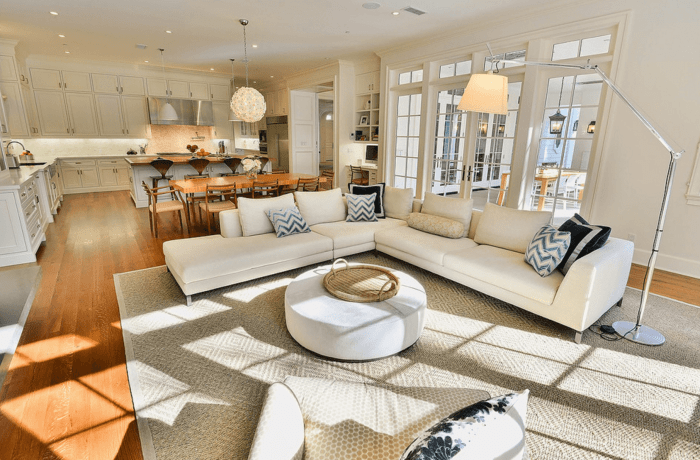
Exploring the realm of Interior Design for Open Concept Living, this piece delves into the art of creating functional yet visually appealing spaces within open layouts. From defining zones to incorporating design elements, discover how to elevate your living space effortlessly.
In the following sections, we will delve into the importance of functional spaces, garden ideas, and key design elements for open concept living, providing you with valuable insights to enhance your home.
Functional Spaces in Open Concept Living

In an open concept living space, defining different functional zones is crucial to create a cohesive and organized layout. By delineating areas for specific activities like cooking, dining, and lounging, you can maximize the usability and aesthetic appeal of the space.
Creating Distinct Areas
- For the cooking area, consider installing a kitchen island or peninsula to separate it from the rest of the space. This not only provides a designated space for meal preparation but also adds a focal point to the room.
- To define the dining area, use a dining table and chairs that complement the overall style of the space. You can also differentiate this zone by adding a pendant light fixture above the table or using a rug under the dining set.
- For the lounging area, arrange furniture such as sofas, armchairs, and coffee tables to create a cozy seating arrangement. Area rugs can help anchor this space, while floor lamps or wall sconces can provide ambient lighting.
Garden Ideas for Open Concept Living

Integrating gardens into open concept living spaces can bring a sense of nature and tranquility indoors. Let’s explore some innovative ideas to incorporate greenery into your home design.
Indoor Gardens
Indoor gardens are a great way to add a touch of nature to your open concept living area. Consider creating a small herb garden in your kitchen or setting up a vertical garden in your living room to bring the outdoors inside.
Vertical Gardens
Vertical gardens are perfect for small spaces and can add a pop of color and texture to your open concept living area. You can use wall-mounted planters or hanging planters to create a lush green wall that serves as a beautiful focal point in your home.
Potted Plants
Potted plants are versatile and easy to incorporate into any open concept living space. Place them strategically around the room to add visual interest and improve air quality. Choose a variety of plant sizes and shapes to create a dynamic and lively atmosphere in your home.
Interior Design Elements for Open Concept Living
Creating a cohesive design aesthetic in an open concept living space involves a careful balance of various elements to ensure a harmonious and visually appealing environment.
Role of Color Schemes, Textures, and Materials
Incorporating different styles in an open concept space can be challenging, but using a consistent color scheme throughout the area can help tie everything together. Whether you prefer a monochromatic look or a mix of complementary colors, choosing a palette that flows seamlessly from one area to another is key. Additionally, playing with textures and materials can add depth and visual interest to the space.
Mixing materials like wood, metal, glass, and fabrics can create a dynamic and inviting atmosphere.
Importance of Flow and Continuity
Maintaining flow and continuity in the design of open concept spaces is crucial to ensure a seamless transition between different areas. Consider the layout of furniture, the placement of accessories, and the overall visual balance of the space to create a cohesive look. Pay attention to sightlines and ensure that the design elements complement each other throughout the space. By maintaining a sense of flow and continuity, you can create a unified and inviting environment for open concept living.
As we conclude our exploration of Interior Design for Open Concept Living, it’s evident that the seamless integration of functional areas, innovative garden concepts, and cohesive design elements can truly transform your living space. By implementing these strategies, you can create a harmonious and inviting environment that reflects your unique style and personality.
Essential Questionnaire
How important is it to define functional zones in open concept living?
Defining functional zones is crucial as it helps create distinct areas for different activities, maintaining organization and flow in the space.
What are some innovative ways to integrate indoor and outdoor spaces in open concept living?
You can explore concepts like indoor gardens, vertical gardens, or incorporating potted plants to seamlessly blend the indoors with the outdoors.
How can different design styles be incorporated while maintaining a cohesive aesthetic in open concept spaces?
By focusing on color schemes, textures, and materials that complement each other, you can achieve a harmonious design despite mixing styles.





